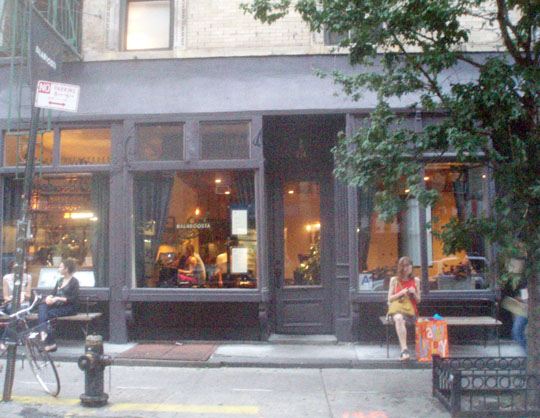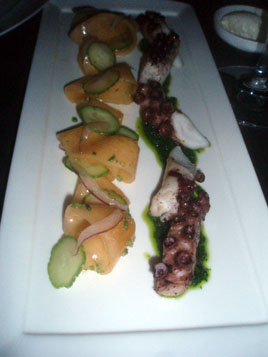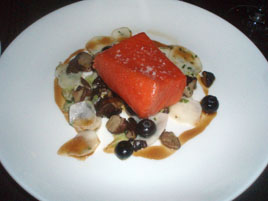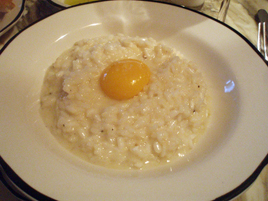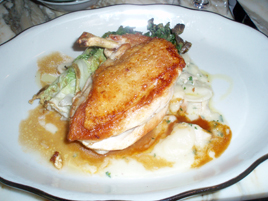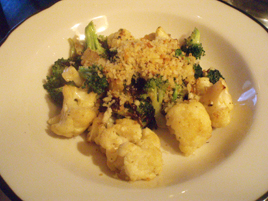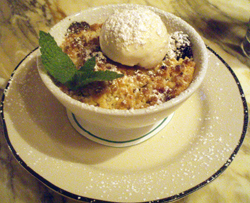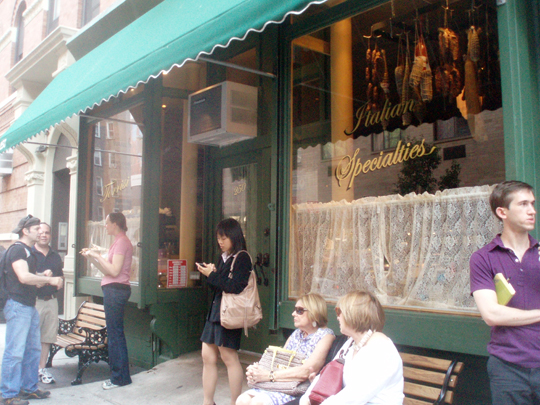
Note: Torrisi Italian Specialties closed at the end of 2014. It is expected to be re-vamped as a fine dining restaurant, and to re-open with a new name in 2015.
The review below was written when Torrisi was still serving a downscale Italian comfort-food menu that many people loved, but I found overrated. It was later remodeled and upgraded, and also started taking reservations. By the time it closed, the restaurant was probably better than the one star I gave it, but I never made it back for another look.
*
 At 7:25 p.m. the other night, a man walked into Torrisi Italian Specialties, and asked, “How long for a table?”
At 7:25 p.m. the other night, a man walked into Torrisi Italian Specialties, and asked, “How long for a table?”
“Ten fifteen,” replied the hostess.
“Ten or fifteen minutes! That’s great!!” the man exclaimed.
“That’s 10:15 at night,” the hostess corrected him.
The crestfallen man departed without leaving his name. He was unwilling to make the hours-long commitment required for the privilege of a prime-time table at this twenty-seat restaurant, which does not accept reservations.
I suspect that Torrisi Italian Specialties has raised the fortunes of every bar in the neighborhood, where diners cool their heels waiting, and waiting, and waiting for the hostess to call when their table is ready. This has been the story for the last few months, ever since Robin Raisfeld and Rob Patronite awarded the improbable restaurant five underground stars in New York, and Sam Sifton awarded two stars in the Times.
Torrisi Italian Specialities occupies an old-school Little Italy storefront. (The neighborhood is called NoLIta today, but it was squarely in Little Italy a century ago.) By day it’s a sandwich shop; by night, a prix fixe restaurant—fifty bucks for eight courses, which change daily. Your only choice is meat or fish for the entrée.
The restaurant plays from a script we’ve seen before: chefs who cut their teeth at three-star restaurants (Del Posto and Café Boulud), now working in the humblest of surroundings, where all the trappings of fine dining are stripped away. They’ve got a smash hit—the equivalent of a Broadway show sold out months in advance.
If you want to dine here, your best option is to show up at around 5:30 p.m. Your margin for error is slim. On a Friday evening, there were already about a dozen people in line at that hour. A few minutes more, and I would have been too late for the first seating.
The hostess, whose watch is synchronized to an atomic clock, emerges at exactly 5:45 to take names. At 6:00 on the dot, she starts escorting diners, one party at a time, into the tiny sandwich shop. They keep the lights low, perhaps to confer a bit of romanticism in such humble surroundings. (The ploy works!)
*
The hardest review to write is of a restaurant that is good—yet, not as good as it’s cracked up to be. I don’t want to give the impression I’m panning the place, because I’m not. Dinner at Torrisi Italian Specialties is enjoyable—once you get in—and you won’t go home hungry. Nobody in town is serving an eight-course Italian feast, especially this good, for just $50.
But objectively speaking, the kitchen is not as accomplished as at nearby Peasant or Locanda Verde, both of which have nailed the rustic Italian genre into which Torrisi fits. And both offer much broader menus, without locking you into an eight-course format. You’ll pay a bit more, but the food will be better, and you can eat at reasonable times without waiting for hours.
And let’s be honest: the chefs, Rich Torrisi and Mario Carbone, drastically limit their degree of difficulty, by limiting your options to a choice between two entrées. To make up for that, they really need to ace every dish, and they don’t.
Every meal has the same format: five antipasti, a pasta, an entrée, and a plate of dessert pastries. Among the antipasti, I counted two winners, two that were merely average, and one dud.
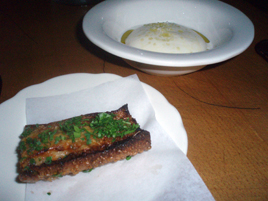
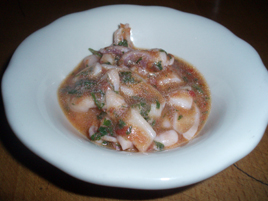
The first antipasto is the only that does not change every day (above left): garlic bread with tomato powder, and warm mozzarella with DaVero olive oil, milk thistle cream, and I believe a dash of sea salt. If you’re accustomed to mozzarella served cold, this is a revelation.
The second was the only dud: calamari marinara (above right). Served cold, it was goopy and bland.
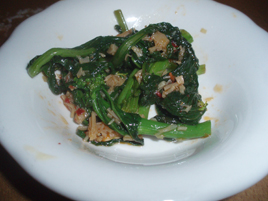
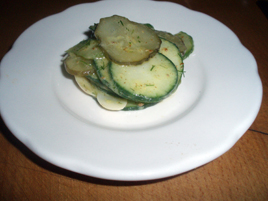
The next two were of no particular distinction; you could probably make them at home: a Broccoli Rabe alla Panama (above left) and a Pickle Salad New Yorkese (above right). The suffixes “alla Panama” and “New Yorkese” weren’t explained.
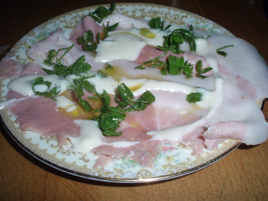

The antipasti finished with another winner: Fresh Ham drizzled with melted Cheddar (above left).
The pasta course was Sheep’s Milk Ricotta Gnocchi (above right). My reaction was that if you add enough garlic and butter, you can’t go too far wrong. Once again, a good Italian cook could make this at home.

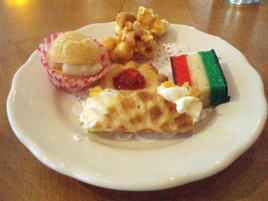
Barbecue Lamb Shoulder (above left) with corona beans and collards had such a haunting smoky flavor that I wondered if the chefs had an unlicensed smoker in the back yard. The server said that it was just a dry rub, left to marinate overnight. (The fish entrée, for the record, was a black bass in Fulton chowder.)
There was a tiny scoop of homemade ice, served in a paper cup, followed by a generous selection of Italian pastries (above right).
The wine list fits on the back of a laminated card, and if you order by the glass—as I did—there is just one each of bubbly, white, rosé, or red, served in a water glass. Service is friendly and efficient, but silverware is not replaced until after the pasta course. By that time, there’s a coating of ooze on the table, where your knife and fork have repeatedly been put down after each plate was cleared.
I can understand the critics’ rapture for a restaurant serving such an enormous amount of food, most of it pretty good, at such a low price. (The prix fixe was just $45 when New York reviewed it.) But Torrisi Italian Specialties is not a two-star restaurant, and the Times does the real two-star restaurants a disservice by saying so. Quite apart from the many amenities it lacks, far too much of the food is rather simplistic.
The menu changes daily and is posted every morning on the restaurant’s website, the cheekily named piginahat.com, so you can decide if it’s worth standing in line for. I’d love to try a few more of the entrées, but to do so, I’d need to sign up for the whole $50 production all over again. I’m not sure if I’m up for that.
Torrisi Italian Specialties (250 Mulberry Street at Prince Street, NoLIta)
Food: ★
Service: ★
Ambiance: ★
Overall: ★
 Monday, March 4, 2013 at 04:20PM
Monday, March 4, 2013 at 04:20PM  The Cleveland is a straightforward seasonal American neighborhood restaurant on the Soho–NoLIta border, where the John Fraser pop-up What Happens When used to be.
The Cleveland is a straightforward seasonal American neighborhood restaurant on the Soho–NoLIta border, where the John Fraser pop-up What Happens When used to be. Pedestrian, rather than creative, is the word I’d use to describe the opening menu of just four small plates ($8–11), five mains ($17–26), and three sides ($6). The mains, for instance: steak, chicken, cod, papardelle, and risotto, none with any unusual take on vegetables that I could make out.
Pedestrian, rather than creative, is the word I’d use to describe the opening menu of just four small plates ($8–11), five mains ($17–26), and three sides ($6). The mains, for instance: steak, chicken, cod, papardelle, and risotto, none with any unusual take on vegetables that I could make out.
































